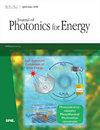空心结构对随机介质微球涂层日间辐射冷却性能的数值增强
IF 2.1
4区 工程技术
Q4 MATERIALS SCIENCE, MULTIDISCIPLINARY
引用次数: 5
摘要
摘要用于被动日间辐射冷却(PDRC)的介电微球涂层由于其低成本和大规模生产的潜力而受到人们的关注。通过设计适合PDRC应用的微球,可以进一步提高冷却性能,有效地反射太阳辐射并向寒冷的天空发射热辐射。为了提高介质微球涂层的PDRC性能,对中空介质结构进行了数值设计。当填充率f = 0.6,外半径径径= 0.5 μm,核壳率φ = rin /径径= 0.3,厚度t = 300 μm,热红外发射率ε¯LWIR = 0.90时,获得最大太阳反射率R¯solar = 0.96。此外,通过控制多尺寸球体分布在φ = 0.1 ~ 0.5范围内,在t = 300 μm处的冷却性能提高到R¯solar = 0.98, ε¯LWIR = 0.95,在25℃温度下的净冷却功率为77 W / m2,比单尺寸球体涂层(φ = 0.3)高约38%,比固体SiO2球体涂层(φ = 0)高约64%。结果表明,中空结构通过增加空气与介质材料之间的界面数量,可以有效地提高介质微球涂层的冷却性能。本文章由计算机程序翻译,如有差异,请以英文原文为准。
Numerically enhancing daytime radiative cooling performance of random dielectric microsphere coatings by hollow structures
Abstract. Dielectric microsphere coatings for passive daytime radiative cooling (PDRC) are gaining attention owing to their low cost and potential for mass production. The cooling performance could be further enhanced to effectively reflect solar radiation and emit thermal radiation to the cold sky by designing microspheres suitable for PDRC applications. Hollow dielectric structures were numerically designed to enhance the PDRC performance of dielectric microsphere coatings. The maximum solar reflectance (R¯solar = 0.96) was obtained with a fill rate f = 0.6, outer radius rout = 0.5 μm, core–shell rate φ = rin / rout = 0.3, thickness t = 300 μm, and thermal infrared emittance ε¯LWIR = 0.90. Furthermore, by controlling the multisize sphere distribution within φ = 0.1 to 0.5, the cooling performance at t = 300 μm was enhanced to R¯solar = 0.98, ε¯LWIR = 0.95, and a net cooling power of 77 W / m2 was achieved at a temperature of 25°C, which was ∼38 % higher than that achieved with the single-size sphere coating (φ = 0.3) and ∼64 % higher than that of the solid SiO2 sphere coating (φ = 0). These results indicate that hollow structures can effectively enhance the cooling performance of dielectric microsphere coatings by increasing the number of interfaces between the air and dielectric materials.
求助全文
通过发布文献求助,成功后即可免费获取论文全文。
去求助
来源期刊

Journal of Photonics for Energy
MATERIALS SCIENCE, MULTIDISCIPLINARY-OPTICS
CiteScore
3.20
自引率
5.90%
发文量
28
审稿时长
>12 weeks
期刊介绍:
The Journal of Photonics for Energy publishes peer-reviewed papers covering fundamental and applied research areas focused on the applications of photonics for renewable energy harvesting, conversion, storage, distribution, monitoring, consumption, and efficient usage.
 求助内容:
求助内容: 应助结果提醒方式:
应助结果提醒方式:


